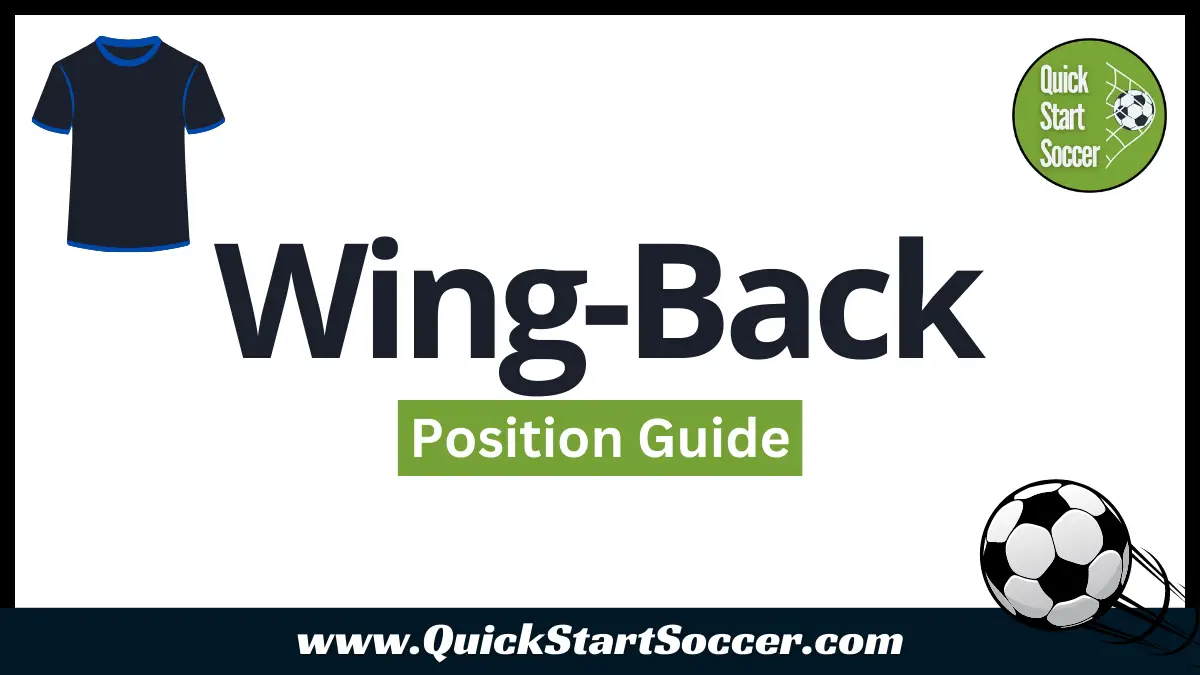The Wing Back Position In Soccer | A Complete Guide
Due to its similarity to the full-back position, the wing-back position in soccer is one that can slip under the radar of soccer analysts and supporters alike. However, with many teams and coaches now using a variety of formations and tactics within a given season, a detailed understanding of this nuanced position is essential for soccer coaches, players, and enthusiasts. In this guide, we will explain what a wing-back in soccer is and how to play in the left or right wing-back position. We’ll also look at the different formations that use wing backs and some of the best players who have played the position in recent times.
What Is The Wing-Back Position In Soccer?

The wing-back position in soccer is a combination of traditional full-back and winger roles. Wing-backs play in the wide areas of the field, and you usually see them in the 3-5-2 or 3-4-3 formations. When a team is out of possession, wing backs act as left and right full-backs on either side of the back 3 to create a back 5. In possession, wingbacks push forward and give the team width as they link up with the midfield and forward lines. It is for this reason that they are referred to as ‘wing-backs’. They act as wingers when their team is in possession and full-backs when they are not!
What Formations Use Wing-Backs In Soccer?
The 3-5-2 and the 3-4-3 are the two most commonly used formations that utilize wing backs in 11v11 soccer. All other formations (such as the 4-3-3, the 4-4-2, 4-5-1, and the 4-2-3-1) utilize fullbacks and wingers.
What Is The Difference Between A Wing-Back And A Full-Back?
Full-backs play in teams that also have wingers or wide forwards, whereas wing-backs do not. As such, in formations such as the 3-5-2 or 3-4-3, wing-backs provide the main width in the team in both defense and attack. Although full-backs can and do help in this area, they do this with the aid of other players that operate in the wide channels (such as a traditional number 7 or number 11).
Another key difference is that full-backs operate in back 4’s (with two central defenders), and wing-backs operate in back 5’s (with three central defenders). As such, a team that plays with wing-backs can usually defend a larger area of the field in the defensive third.
How To Play In The Wing-Back Position?
Qualities Needed:
A good wing-back has to be physically fit. They have to be capable of contributing equally in both defense and attack. They also need to be technically and tactically sound so they can understand and execute their role within the team successfully. Consequently, it is essential that a wing-back has a wide range of competencies. Below are the most important qualities of a good wingback in soccer:
- A high level of physical fitness as well as speed. Wing-backs have the dual responsibility of giving the team width in attack as well as defending wide areas of the field when out of possession. As such, being physically fit is the minimum demand for this difficult position.
- They need to be effective defenders in 1v1 situations. Wing-backs will invariably be matched up against fast and tricky wingers. Being able to make tackles and win 1v1 duels is a must for any aspiring wing-back.
- They must be competent dribbers and comfortable on the ball in attacking situations. A good wingback offers as much going forward as they do working back.
- They need to have a good understanding of basic defensive principles, i.e., the need to stay compact as a team, protect the goal, and apply pressure on the ball along with cover, balance, and support.
- An ability to receive the ball under high pressure and still help the team maintain possession when building out the back.
- Being technically competent enough to pass the ball over short and long distances.
- The ability to recognize moments to make penetrating runs to break the opponent’s defensive lines.
- Be able to make good and accurate crosses into the penalty area, both from deep and from the by-line.
How To Play As A Wing-Back When Attacking
As the players that provide the main width in attack, wing backs have a lot of responsibilities when their team has the ball. If a wingback is not contributing in an attacking sense, they are not really contributing! To play as a good attacking wing-back, a player needs to do the following:
- When central defenders are looking to give the team maximum width and build from the back, a good attacking wing-back will provide forward passing options for the three central defenders and goalkeeper at all times.
- When possessing the ball in the opponent’s half, a wing-back should look to combine with central midfielders and forwards to try and break the opponent’s defensive lines and create opportunities for themselves and others.
- When receiving the ball in these wide areas in either of the above situations, wing-backs should have their hips open to the rest of the field and look to receive on their back foot. By doing this, players will consistently have the option to play either forward (if possible) or backward (if necessary).
- Constantly look to push forward and aggressively join in attacks whenever their team has possession in the opponent’s half of the field.
- Actively look for chances to make overlapping and underlapping runs to get behind the opponent’s defense, particularly when forwards and midfielders have time and space on the ball.
- Look for opportunities to play early crosses into the box, particularly against an unbalanced or disorganized defense.
- Make penetrative passes for forwards, attacking midfielders, or even the corresponding wing-back on the other side of the field.
- During quick counterattacks, a wind-back should be prepared to carry the ball forward into the middle and offensive thirds, particularly when given ample time and space to run into.
How To Play As A Wing-Back When Defending
Wing-backs are defenders as much as they are midfielders and attackers. This is why the wing-back position is seen as one of the most physically demanding on the field! Defending primarily in wide areas, wing-backs need to prevent opposition players from penetrating their own defensive lines and putting crosses in or even scoring.
They need to be as strong defensively as they are offensively in 1v1 situations. They also need to be able to work well and in conjunction with their three central defenders and the far-side wing-back. To be a good wing-back when defending, a player needs to do the following:
- Recognize moments when they are the 1st defender (usually when they are closest to the ball in wide areas) and apply pressure to the player in possession.
- Win 1v1 duels through well-timed challenges, tackles, and interceptions. This will often be against the opposing winger or outside forward.
- Prevent shots and crosses entering the penalty area from wide areas. If conceding a cross or shot, apply as much pressure as possible to try and affect the overall quality of the attempt.
- Be consistently aware of the positioning of their fellow defenders. If a wingback cannot win the ball directly, forcing an opponent to pass to someone under pressure or into a congested area is the next best thing!
- Provide balance and stay connected with the team’s three central defenders when the opponents are attacking the opposite side of the field. Be aware of any weak side runs from the opponent’s wingers and fullbacks.
- When defending deep and in central areas, hold a steady and compact line with the three center-backs and the opposite wing-back. Be able to anticipate through balls and either drop deep to recover or push up to catch the opponent offside.
- Look to intercept penetrative passes made behind the defense in the area between the wing-back and the closest center-back.
- When the opponent is putting crosses into the box from the opposite side of the field, a good wingback needs to be comfortable winning headers and attacking the ball in the air. They need to be prepared to put their body on the line in order to prevent a chance or a shot on goal.
The Best Wing-Back Players
Reece James
Reece James often occupies the role of wing-back for both Chelsea and England when their teams play 3-4-3. Reece James is as effective in defense as he is in attack, being hard to beat on the dribble and also possessing a devastating crossing ability in the final third.
Ivan Perisic
The experienced Croatian soccer play is currently plying his trade at Tottenham Hotspurs in the English Premier League. Under Antonio Conte, the former winger is excelling in the left wing-back position in both 3-5-2 and 3-4-3 formations (Conte has been using both during his hotspurs’ reign). His creative ability on the ball and his strong positional sense make him the perfect fit for the role.
Alphonso Davis
The Canadian prodigy has played left full-back, winger, and left wing-back for Bayern Munich and is excelling in all three of them! His speed and athleticism, combined with his quick feet and dribbling ability, make him one of the world’s most exciting young players and a perfect fit for the wing-back role.
More Soccer Position Guides
As you can see, the wing-back position in soccer is an exciting position that, when used effectively, can give any team the edge in competitive matches. Before you go, be sure to check out our other position guides by clicking on the button below.

